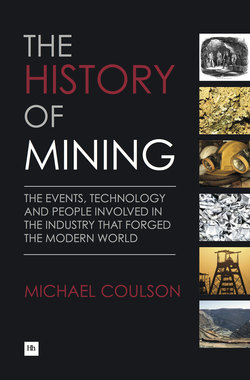Читать книгу The History of Mining - Michael Coulson - Страница 47
На сайте Литреса книга снята с продажи.
9. Gold, Silver and the Spanish Conquistadors
ОглавлениеOne of the most wide-reaching events in the Middle Ages as far as metals and mining are concerned was the arrival of the Spanish Conquistadors in Latin America. If the Middle Ages ended with the Reformation and the dislocation that ensued, its golden time was surely the Renaissance when art and culture began to blossom – the first indications of an economic revolution to come were seen in the form of the futuristic sketchings of Leonardo de Vinci.
The Spanish certainly were inspired by the atmosphere of the Renaissance to sail out into the Atlantic, pushing west in the hope of finding a route to the east – in particular India and China – where riches in the form of spices, not to mention gold, beckoned. The Portuguese had earlier sailed into the Atlantic, also anxious to find a passage to India that did not take them through the lands of the Ottoman Empire; they first turned south to probe the west coast of Africa.
So it was that in 1492 Christopher Columbus, an Italian sea captain, supported and equipped by Queen Isabella and King Ferdinand of Spain, set sail for India going west across the Atlantic. Columbus made landfall in the Caribbean on the island of San Salvador, far from his target of India and the east. Over the years he made a number of trips to what became known as the West Indies, landing on Haiti, Jamaica and Cuba and establishing administrations there. Despite his pioneering success Columbus found little gold and certainly no spices and in due course he was recalled to Spain, having fallen out with the Spanish crown.
It was not, however, the case that the Spanish interest in Latin America’s gold and silver came about as a result of any plan to explore for and then mine gold. Whilst Spain has a long history of mining, the Conquistadors were adventurers and though gold was their primary target they thought that their voyage across the Atlantic would bring them to India eventually, where it was rumoured that great quantities of gold, already mined, were to be found. When they reached the West Indies the Spanish did find some gold on Haiti, but it needed mining and the Conquistadors were really looking to acquire mined gold by trading other goods for it and then shipping it back to Spain for the Crown’s treasury.
The Haitian gold operations were basically alluvial, mining river beds and streams, and the miners were indentured native Indians who the Spanish treated harshly with the consequence that many of them died, and were then replaced by slaves from west Africa. The Spanish in due course opened gold mines on Cuba. The gold mined was shipped back to Seville in Spain, which was the designated port where the gold had to be landed, and here it was delivered to the Casa de Contratacion which was the depot built to receive American gold.
Whilst the quantity of gold found on the Caribbean islands occupied by the Spanish was relatively modest, rumours abounded of great riches in a land called Mexico to the west. It was Hernan Cortez, an adventurer who had fallen out with the Cuban governor, who decided to flee Cuba before more trouble ensued and set sail for Mexico with a force of 600 men. There he encountered the Aztec civilisation, and gold.
Cortez found the rumours about gold in Mexico were correct and the natives were prepared to trade gold for beads and other trinkets, but the amount of gold that the natives had was not enough for Cortez. Fortunately for the Spanish, the natives knew where there was abundant gold – it was in the hands of the Aztecs, who were the most powerful civilisation in Central America at the time and who had a history of great cruelty in pursuing their geo-political aims. Unfortunately for the Aztecs the Conquistadors were even crueller and more ruthless than they were.
Initially the Spanish got on well with the Aztecs – the Aztecs showed great respect to their guests, being particularly impressed by their exotic white skin and formidable weapons and armour. The Aztecs were also happy to feed their gold lust, as they saw no value in the metal itself except as a raw material with which to make artefacts, and many of these artefacts were willingly given as presents to the Spanish. In the end gold lust drove Cortez to sack the Aztec capital of Tenochtitlan and, through a combination of the sword and European diseases introduced by the Spanish, he destroyed the Aztec civilisation.
